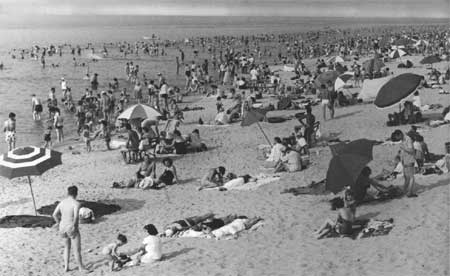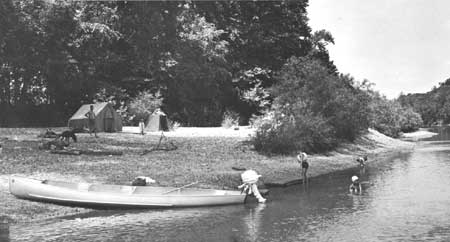.gif)
Parks for America
MENU
|
Parks for America
|

|
NORTH CENTRAL
The variations in physiographic and socioeconomic characteristics contained within this region can be appreciated by considering that it encompasses 12 States and includes the Dakotas in the west and Ohio in the east, Missouri in the south, and Minnesota in the north. The outdoor recreation resources and the need for protection, land acquisition, and development of facilities are equally diversified.
This diversity has brought about regional outdoor recreation use patterns and problems, and a resulting need for coordinated planning efforts at the region-wide, interstate, State, and local levels. Elements accenting this need are the metropolitan complexes sprawling across State boundaries; the dominance of the Great Lakes in the North Central recreation resource picture calling for both interstate and regional planning for parks and recreation areas along the shores; the summer migration from the hot farm belt to the cool forest and lake country of northern Minnesota, Wisconsin, and Michigan; the winter travel to winter sports areas; and planning for development of the Mississippi, Missouri, and Ohio River Basins. The development of the Interstate Highway network will accentuate the importance of regionwide planning.
The climate ranges from the cold winters of the Lake States and Great Plains to the relatively mild winters of southern Missouri, Illinois, Indiana, and Ohio. While the northern areas endure frigid winter conditions (which offer ideal winter sports opportunities), they enjoy a pleasant summer climate with the exception of the Great Plains area in the west, where hot summers with cool evenings are the rule. In the south, the heat of summer combined with the humidity of the lowland results in a period each year during which much recreation travel is directed away from that portion of the region. Spring and fall are delightful, and there is considerable variation as to the time of occurrence of this pleasant weather within the region.
Population density ranges from the congestion of urban, commercial-industrial centers such as Chicago, Detroit, and Cleveland, through the relatively evenly distributed rural populations of the highly productive Corn Belt to the sparsely settled areas in the western and northern extremities. From all indications it would appear that those areas with high population density will become even more populous, and that those with few inhabitants will continue to have lower rates of population growth. Twenty-nine percent of the population of the 48 contiguous States reside in this region.
The contribution of outdoor recreation to the total economy of the North Central region ranks high. The areas enjoying the major portion of the income from tourism are in the Northwoods-Lakes regions of Minnesota, Wisconsin, and Michigan.
Reasonably accessible to the urban population concentrations around Minneapolis-St. Paul, Milwaukee, Chicago, Detroit, and Cleveland and blessed with a climate which is ideal for both summer and winter outdoor activities, this area must logically be expected to receive heavy recreation use. There are, to be sure, other areas within the region which do now or could, with appropriate development and promotion, receive substantial income from recreation-tourism. This pattern of outdoor recreation use points up the influence that the hot, frequently humid summer climate exerts on the inhabitants of the southern and central portion of the region in their choice of summer recreation locale. Water-oriented activities here are predominant, and rivers, lakes, and reservoirs receive heavy recreational use during the summer.
The historical beginnings of the West appear here. This is the country of the voyageurs, fur traders, and the pathfinders for westward expansion. The whole region is interlaced with interesting dates and places relating to the first adventurous trappers—the first white men—the beginnings of the Civil War, westward expansion, and Indian wars. This wealth of historical interest remains today as only a lightly tapped recreation resource.
Private enterprise in the recreation industry plays an important part in providing needed services to recreationists in this region. These services range in type from those aimed at transients to services for vacationers. Private development without regard for the public interest has, in some places, resulted in damage to the basic resource. In other cases, private groups have exhibited no interest in developing what they consider to be only marginal recreation resources. This history of development has resulted in pockets of extremely heavy use of the best resources, to their detriment, and a dearth of development of less apparent resources. These latter areas could, with a minimum of capital expenditure, contribute materially toward the satisfaction of the need for additional outdoor recreation opportunity, frequently nearer to the people who need it than the more easily developed resources.

|
| Water is the key to recreation throughout the North Central States. Recreation resources range from beach areas like Indiana Dunes State Park . . To secluded streams like the Gasconade in Missouri, meriting protection as free-flowing stream. ((top) ARTHUR E. ANDERSON; (bottom) DON WOOLDRIDGE, MISSOURI CONSERVATION COMMISSION.) |

|
The automobile and the cartop or trailer boat are symbolic of the recreation-bent inhabitants of this region. Relatively rarely do trains or airplanes contribute to the conveyance of the recreationist to the facility.
Existing public park and recreation programs in the region vary in effectiveness from those just getting under way to those which are well established. In most of the States, insufficient attention has been given to the recreation needs of the inhabitants of the urban areas, and day-use and weekend facilities are inadequate.
In some cases, vacation facilities approach adequacy. One of the bases for provision of such facilities by public agencies has been to continue attracting an influx of vacationing people into the States for economic reasons.
A few broad conclusions can be drawn from all these interacting influences affecting recreation in the region. As population increases and the other factors contributing to increases in recreation demand continue to mount, there will be constantly growing needs for recreation facilities of all types in every locale. Additional facilities near urban concentrations are, of course, extremely important.
Several of the areas have abundant recreation resources that lend themselves to vacation use. Heavy use by vacationers already occurs in some areas, while others are just recently beginning to feel this pressure. Preservation of the major attracting resources must be achieved in order that the motivating force for a refreshing outdoor experience can remain. Similarly, the preservation of outstanding natural and wilderness areas with very limited development is an important goal.
Reservoirs, both multiple purpose and those with recreation as the primary purpose, can contribute substantially to satisfying the need for water-oriented recreation in areas of the region where natural water bodies are insufficient. Where their construction is feasible and there is a deficit of water-oriented recreation opportunity near urban concentrations, artificial impoundments can be located near urban populations.
The wealth of historical interest throughout the region could be cataloged and evaluated, and information disseminated that would help to unify the multitude of occurrences, names, places, and dates into an understandable panorama of their significance in the development of the Nation. Interpretive devices, brochures, and historic routes can help the public understand, enjoy, and appreciate the courage and perseverance of those who preceded them. Protection through public ownership of the most outstanding areas would help toward preserving significant parts of Americana for coming generations.
The wide divergence in recreation needs within this region plus the fact that it contains major vacation resources of value to the Nation dictate the necessary types of conservation and recreation programs and the important roles served by both private and public recreation. The actions taken should be considered on a regional basis designed to meet the needs of the people of the Great Plains, the metropolitan areas, the Corn Belt, and the Northwoods. The regional needs have been considered in the individual State plans that follow.
NEXT >>>
|
|
Last Modified: Mon, Sep 6 2004 10:00:00 pm PDT
parks_america/north_central.htm
 Top
Top